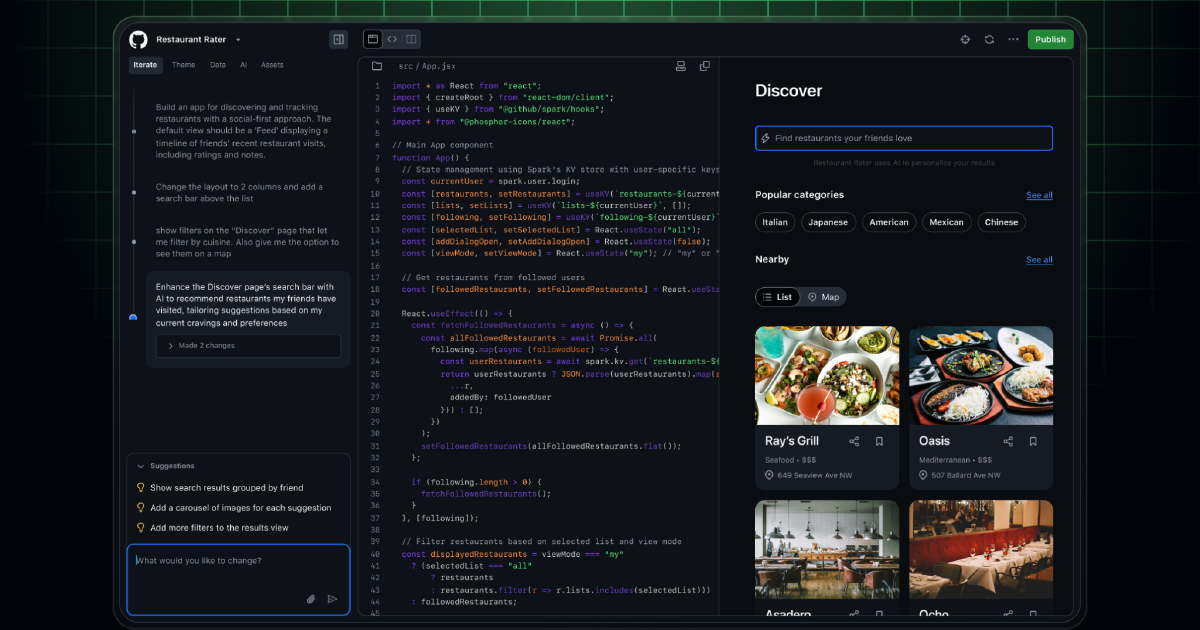GitHub just launched Spark in public preview for Copilot Enterprise customers. The pitch is simple: describe your app idea in natural language and watch GitHub build it for you.
This isn’t another no-code tool. It’s GitHub betting that the future of software development starts with conversation, not code.
What GitHub Spark does#
Natural language to working app: Describe what you want and Spark builds it. Frontend, backend, data storage, authentication, hosting. All included.
No setup friction: No environment configuration, no API key management, no deployment headaches. Everything works out of the box within GitHub’s infrastructure.
AI-powered features: Built-in access to LLMs from OpenAI, Meta, DeepSeek, and xAI. Add intelligent features to your apps without managing API keys or billing.
One-click everything: Deploy your app with a single click. Share it securely with your team. Create a full GitHub repository when you’re ready to expand.
How it works in practice#
Based on GitHub’s announcement, here’s the typical flow:
- Describe your idea: “Build a team expense tracker with receipt uploads and approval workflows”
- Watch it build: Spark generates the frontend, backend logic, database schema, and user interface
- Iterate naturally: “Add email notifications when expenses are approved” or “Make the UI more mobile-friendly”
- Deploy instantly: One click publishes your app with secure sharing controls
- Expand when ready: Convert to a full repository and continue development with Copilot
You can switch between natural language, visual editing, or traditional coding at any point. The tool adapts to how you want to work.
What makes this different#
Built into GitHub’s ecosystem#
This isn’t a standalone platform. Spark integrates with:
- GitHub repositories: Convert prototypes to full repos seamlessly
- Codespaces: Jump into a development environment when you need more control
- Copilot agents: Hand off complex tasks to AI coding agents
- Dependabot: Security and dependency management included
Enterprise-ready from day one#
Available only to Copilot Enterprise customers with:
- Enterprise security: Built on GitHub’s enterprise infrastructure
- Team collaboration: Multiple stakeholders can work on the same prototype
- Admin controls: Enterprise admins control who has access
- Integration: Works with existing GitHub workflows and permissions
Focus on the “what,” not the “how”#
GitHub’s positioning is clear: teams spend too much time on specs and mockups that never make it to production. Spark lets you validate ideas with working prototypes instead of static documents.
Who this is really for#
Product managers and designers#
Finally, a way to test ideas without waiting for developer bandwidth. Build interactive prototypes that stakeholders can actually use and provide feedback on.
Internal tool builders#
Every organization has dozens of small tools they need but never build. Expense trackers, approval workflows, data dashboards. Spark makes these feasible.
Rapid validation teams#
Test market assumptions with working software, not wireframes. Get user feedback on actual functionality, not theoretical concepts.
Cross-functional collaboration#
Developers, PMs, designers, and business stakeholders can all contribute to the same prototype using their preferred methods (code, visual editing, or natural language).
The technical reality#
What Spark handles well:
- Standard web app patterns (CRUD operations, user auth, data visualization)
- Common business workflows (approvals, notifications, reporting)
- Integration with popular APIs and services
- Responsive UI generation
What it probably struggles with:
- Complex algorithms or specialized business logic
- Performance-critical applications
- Highly customized user experiences
- Integration with legacy enterprise systems
The sweet spot: Internal tools, prototypes, and standard business applications that follow common patterns.
Enterprise rollout details#
Availability: Public preview for Copilot Enterprise customers only Default state: Disabled (admins must explicitly enable it) Access: Available at github.com/spark once enabled Usage: Counts against Copilot premium request quotas
To enable for your organization:
- Navigate to Enterprise Policies on GitHub
- Select Copilot in the sidebar
- Find “Spark” in the Features section
- Change policy to “Enabled”
What this signals about GitHub’s strategy#
Beyond code hosting: GitHub is positioning itself as the complete platform for software development, from idea to production.
AI-first development: This is GitHub’s bet that natural language will become a primary interface for software creation.
Enterprise focus: By launching exclusively for Enterprise customers, GitHub is targeting the market with the biggest pain around rapid prototyping and internal tools.
Platform lock-in: Once teams build workflows around Spark, they’re deeply integrated into GitHub’s ecosystem. That’s valuable for retention and expansion.
The bigger questions#
What happens to traditional development? If you can describe an app and have it built automatically, what skills become valuable for developers?
How good is “good enough”? Spark-generated apps might work for 80% of use cases. What happens to the remaining 20% that need custom solutions?
Who owns the generated code? When AI builds your application, what are the intellectual property implications?
What about vendor lock-in? Spark makes it easy to start building on GitHub’s platform. How easy is it to leave?
My take on the timing#
This launch feels strategic. GitHub is responding to the rise of AI development tools by integrating them directly into their platform rather than letting third parties capture that value.
The enterprise-first approach is smart. Large organizations have the budget for Copilot Enterprise and the biggest pain around rapid prototyping. They’re also less price-sensitive and more willing to adopt new tools if they solve real problems.
The integration story is compelling. Instead of building yet another standalone platform, GitHub is leveraging their existing ecosystem. That reduces friction and increases the likelihood of adoption.
But the real test is execution. Can Spark actually generate useful applications, or will it be another demo-ware tool that looks impressive but fails in practice?
What comes next#
Expect GitHub to:
- Expand availability to other Copilot tiers based on enterprise feedback
- Add more AI models and integration options
- Improve code generation quality based on real-world usage
- Build deeper integrations with GitHub’s existing developer tools
The broader trend: We’re moving toward a world where describing software is as important as writing it. GitHub Spark is positioning itself to be the platform where that transition happens.
For developers: This isn’t about replacement, it’s about elevation. Instead of building standard CRUD apps from scratch, focus on the complex, creative, and strategic work that AI can’t handle yet.
For organizations: The question isn’t whether AI will change how you build software. It’s whether you’ll adopt tools like Spark proactively or wait until competitors gain an advantage.
Learn more: Read GitHub’s full announcement and check the Spark documentation for implementation details.


